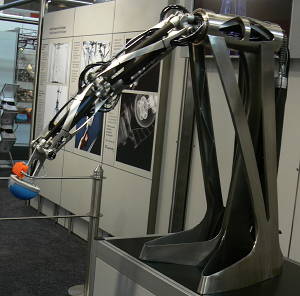Robot arm is powered by pneumatic `muscles`
At the recent Motek materials-handling show in Germany, Festo demonstrated a prototype robotic arm driven by its pneumatically-powered “fluidic muscle” technology. The flexible, four-axis AirArm, which uses 12 muscles of varying sizes, is designed to be better and safer for working with humans than traditional robots, which are optimised for rigidity and positional accuracy.

Unlike conventional robots, whose movements are described using Cartesian co-ordinates, the AirArm is positioned using joint co-ordinates. Festo says the arm is not affected by harsh environments, and could be used where dust or water are present.
Fluidic muscles consist of hollow elastomer cylinders embedded with aramid fibres. When the muscle fills with air, it increases in diameter and contracts in length, producing a fluid, elastic movement. Fluidic muscles can exert ten times the force of a similar-sized pneumatic cylinder. Their motion is similar to that of human movement, not only in terms of kinematics, speed and strength, but also sensitivity.





